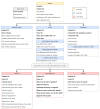From Bedside to Desktop: A Data Protocol for Normative Intracranial EEG and Abnormality Mapping
- PMID: 40432754
- PMCID: PMC12104836
- DOI: 10.21769/BioProtoc.5321
From Bedside to Desktop: A Data Protocol for Normative Intracranial EEG and Abnormality Mapping
Abstract
Normative mapping is a framework used to map population-level features of health-related variables. It is widely used in neuroscience research, but the literature lacks established protocols in modalities that do not support healthy control measurements, such as intracranial electroencephalograms (icEEG). An icEEG normative map would allow researchers to learn about population-level brain activity and enable the comparison of individual data against these norms to identify abnormalities. Currently, no standardised guide exists for transforming clinical data into a normative, regional icEEG map. Papers often cite different software and numerous articles to summarise the lengthy method, making it laborious for other researchers to understand or apply the process. Our protocol seeks to fill this gap by providing a dataflow guide and key decision points that summarise existing methods. This protocol was heavily used in published works from our own lab (twelve peer-reviewed journal publications). Briefly, we take as input the icEEG recordings and neuroimaging data from people with epilepsy who are undergoing evaluation for resective surgery. As final outputs, we obtain a normative icEEG map, comprising signal properties localised to brain regions. Optionally, we can also process new subjects through the same pipeline and obtain their z-scores (or centiles) in each brain region for abnormality detection and localisation. To date, a single, cohesive dataflow pipeline for generating normative icEEG maps, along with abnormality mapping, has not been created. We envisage that this dataflow guide will not only increase understanding and application of normative mapping methods but will also improve the consistency and quality of studies in the field. Key features • Resultant normative maps can be used to test a broad range of hypotheses in the neuroscience field. • Provides a more detailed walkthrough of the methods in the normative mapping study conducted by Taylor et al. [1] and other related publications [2-12]. • Offers flexibility: readers can tailor the final output by considering key decision points included throughout the protocol. • Involves sub-pipelines, which may be useful to researchers in isolation (i.e., icEEG electrode localisation and/or interictal segment selection).
Keywords: Abnormality mapping; Computational methods; Data pipeline; EEG; Epilepsy; Neuroimaging; Neuroscience; Normative mapping.
©Copyright : © 2025 The Authors; This is an open access article under the CC BY license.
Conflict of interest statement
Competing interestsThe authors have no competing interests to disclose.
Figures





References
-
- Taylor P. N., Papasavvas C. A., Owen T. W., Schroeder G. M., Hutchings F. E., Chowdhury F. A., Diehl B., Duncan J. S., McEvoy A. W., Miserocchi A., et al. .(2022). Normative brain mapping of interictal intracranial EEG to localize epileptogenic tissue. Brain. 145(3): 939 949 949. 10.1093/brain/awab380 - DOI - PMC - PubMed
-
- Horsley J. J., Thomas R. H., Chowdhury F. A., Diehl B., McEvoy A. W., Miserocchi A., de Tisi J., Vos S. B., Walker M. C., Winston G. P., et al. .(2023). Complementary structural and functional abnormalities to localise epileptogenic tissue. EBioMedicine. 97: 104848 10.1016/j.ebiom .2023.104848 - DOI - PMC - PubMed
-
- Owen T. W., Janiukstyte V., Hall G. R., Chowdhury F. A., Diehl B., McEvoy A., Miserocchi A., de Tisi J., Duncan J. S., Rugg-Gunn F., et al. .(2023). Interictal magnetoencephalography abnormalities to guide intracranial electrode implantation and predict surgical outcome. Brain Commun. 5(6): e1093/braincomms/fcad292. 10.1093/braincomms/fcad292 - DOI - PMC - PubMed
-
- Wang Y., Schroeder G. M., Horsley J. J., Panagiotopoulou M., Chowdhury F. A., Diehl B., Duncan J. S., McEvoy A. W., Miserocchi A., de Tisi J., et al. .(2023). Temporal stability of intracranial electroencephalographic abnormality maps for localizing epileptogenic tissue. Epilepsia. 64(8): 2070 2080 2080. 10.1111/epi.17663 - DOI - PMC - PubMed
LinkOut - more resources
Full Text Sources
Research Materials
Miscellaneous

